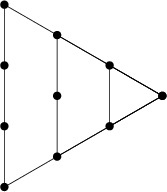|
|
|

A Figurate Number of the form
![]() obtained by building up regular triangles out of dots. The first
few triangle numbers are 1, 3, 6, 10, 15, 21, ... (Sloane's A000217).
obtained by building up regular triangles out of dots. The first
few triangle numbers are 1, 3, 6, 10, 15, 21, ... (Sloane's A000217). ![]() gives the number and arrangement of
Bowling pins, while
gives the number and arrangement of
Bowling pins, while ![]() gives the number and arrangement of balls in Billiards. Triangular numbers
satisfy the Recurrence Relation
gives the number and arrangement of balls in Billiards. Triangular numbers
satisfy the Recurrence Relation
| (1) |
| (2) | |||
| (3) | |||
| (4) |
| (5) |
| (6) |
Every triangular number is also a Hexagonal Number, since
| (7) |
| (8) |
Interesting identities involving triangular numbers and Square Numbers are
 |
(9) |
 |
(10) |
| (11) |
| (12) |
All Even Perfect Numbers are triangular ![]() with Prime
with Prime ![]() . Furthermore, every Even
Perfect Number
. Furthermore, every Even
Perfect Number ![]() is of the form
is of the form
| (13) |
| (14) |
The numbers 1, 36, 1225, 41616, 1413721, 48024900, ... (Sloane's A001110) are Square Triangular Numbers, i.e., numbers which are simultaneously triangular and Square (Pietenpol
1962). Numbers which are simultaneously triangular and Tetrahedral satisfy the
Binomial Coefficient equation
| (15) |
The smallest of two Integers for
which ![]() is four times a triangular number is 5 (Cesaro 1886; Le Lionnais 1983, p. 56). The only Fibonacci
Numbers which are triangular are 1, 3, 21, and 55 (Ming 1989), and the only Pell Number which is
triangular is 1 (McDaniel 1996). The Beast Number 666 is triangular, since
is four times a triangular number is 5 (Cesaro 1886; Le Lionnais 1983, p. 56). The only Fibonacci
Numbers which are triangular are 1, 3, 21, and 55 (Ming 1989), and the only Pell Number which is
triangular is 1 (McDaniel 1996). The Beast Number 666 is triangular, since
| (16) |
Fermat's Polygonal Number Theorem states that every Positive Integer is a sum of most three
Triangular Numbers, four Square Numbers, five Pentagonal
Numbers, and ![]()
![]() -Polygonal Numbers. Gauß
-Polygonal Numbers. Gauß ![]() proved the
triangular case, and noted the event in his diary on July 10, 1796, with the notation
proved the
triangular case, and noted the event in his diary on July 10, 1796, with the notation
| (17) |
The only triangular numbers which are the Product of three consecutive Integers are 6, 120, 210, 990, 185136, 258474216 (Guy 1994, p. 148).
See also Figurate Number, Pronic Number, Square Triangular Number
References
Ball, W. W. R. and Coxeter, H. S. M. Mathematical Recreations and Essays, 13th ed. New York: Dover, p. 59, 1987.
Bellew, D. W. and Weger, R. C. ``Repdigit Triangular Numbers.'' J. Recr. Math. 8, 96-97, 1975-76.
Conway, J. H. and Guy, R. K. The Book of Numbers. New York: Springer-Verlag, pp. 33-38, 1996.
Deligne, P. ``La Conjecture de Weil.'' Inst. Hautes Études Sci. Pub. Math. 43, 273-308, 1973.
Dudeney, H. E. Amusements in Mathematics. New York: Dover, pp. 67 and 167, 1970.
Duke, W. ``Some Old Problems and New Results about Quadratic Forms.'' Not. Amer. Math. Soc. 44, 190-196, 1997.
Eaton, C. F. ``Problem 1482.'' Math. Mag. 68, 307, 1995.
Eaton, C. F. ``Perfect Number in Terms of Triangular Numbers.'' Solution to Problem 1482. Math. Mag. 69, 308-309, 1996.
Guy, R. K. ``Sums of Squares'' and ``Figurate Numbers.'' §C20 and §D3 in
Unsolved Problems in Number Theory, 2nd ed. New York: Springer-Verlag, pp. 136-138 and 147-150, 1994.
Hindin, H. ``Stars, Hexes, Triangular Numbers and Pythagorean Triples.'' J. Recr. Math. 16, 191-193, 1983-1984.
Le Lionnais, F. Les nombres remarquables. Paris: Hermann, p. 56, 1983.
McDaniel, W. L. ``Triangular Numbers in the Pell Sequence.'' Fib. Quart. 34, 105-107, 1996.
Ming, L. ``On Triangular Fibonacci Numbers.'' Fib. Quart. 27, 98-108, 1989.
Pappas, T. ``Triangular, Square & Pentagonal Numbers.'' The Joy of Mathematics.
San Carlos, CA: Wide World Publ./Tetra, p. 214, 1989.
Pietenpol, J. L ``Square Triangular Numbers.'' Amer. Math. Monthly 169, 168-169, 1962.
Satyanarayana, U. V. ``On the Representation of Numbers as the Sum of Triangular Numbers.'' Math. Gaz. 45, 40-43, 1961.
Sloane, N. J. A. Sequences
A000217/M2535
and A001110/M5259
in ``An On-Line Version of the Encyclopedia of Integer Sequences.''
http://www.research.att.com/~njas/sequences/eisonline.html and Sloane, N. J. A. and Plouffe, S.
The Encyclopedia of Integer Sequences. San Diego: Academic Press, 1995.
|
|
|
© 1996-9 Eric W. Weisstein